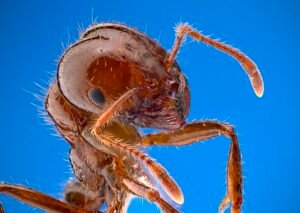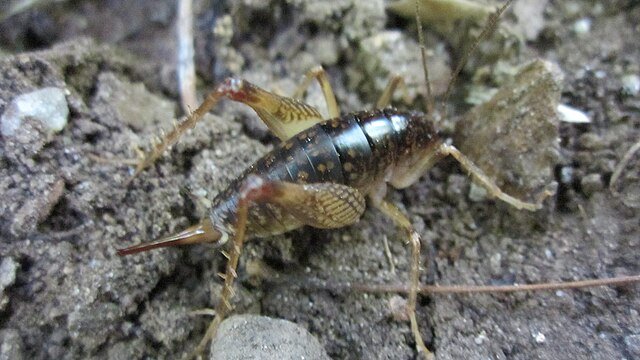Fire Ants: Identification, Biology, Risks, and Control
 The fire ant (Solenopsis invicta), often called the red imported fire ant, is one of the most aggressive invasive insects in the world. Native to South America but now spread across the southern United States, Asia, and Australia, this species is infamous for its painful sting and its ability to cause ecological, agricultural, and economic damage.
The fire ant (Solenopsis invicta), often called the red imported fire ant, is one of the most aggressive invasive insects in the world. Native to South America but now spread across the southern United States, Asia, and Australia, this species is infamous for its painful sting and its ability to cause ecological, agricultural, and economic damage.
Unlike nuisance ants such as the Argentine ant (Linepithema humile) or the odorous house ant (Tapinoma sessile), fire ants pose direct risks to human health, pets, and livestock. They are highly territorial, quick to attack, and capable of delivering venom that can trigger allergic reactions.
Understanding their biology, signs of infestation, and advanced control strategies is crucial for farmers, homeowners, and pest control professionals.
Identification
Fire ants can be mistaken for harmless native ants, but careful observation reveals clear differences.
Size: Workers vary in size (2.4–6 mm), a trait called polymorphism.
Color: Reddish-brown to dark brown with a darker abdomen.
Body features: One-segmented petiole with two nodes, stinger present.
Behavior: Extremely aggressive; disturbed nests release hundreds of stinging workers in seconds.
Mounds: Large dome-shaped nests in soil, often without a visible entrance hole at the top.
Colonies may contain single or multiple queens. Their aggressive defense of mounds is one of the easiest field indicators.
Biology and Ecology
Colony structure
Monogyne colonies: Single queen, highly territorial, smaller spread.
Polygyne colonies: Multiple queens, denser populations, and faster spread.
Reproduction
Winged males and females perform nuptial flights, mate, and establish new colonies.
Fertilized queens shed wings and can produce thousands of eggs.
Feeding habits
Omnivorous diet: feed on plant seeds, insects, carrion, and sugary substances.
Known to prey on spiders, earthworms, and even small vertebrates like birds and lizards.
Adaptations
Excellent flood survival: colonies form “rafts” with workers and brood floating together.
Rapid colony expansion in warm, disturbed habitats.
Global Distribution
Native to central South America, Solenopsis invicta has expanded dramatically due to trade.
United States: Established across the southern states from Texas to Florida, with expansion northward.
Asia: Detected in China, Taiwan, and parts of Southeast Asia.
Australia: Found in Queensland; eradication campaigns ongoing.
Caribbean: Spread to several islands.
They thrive in warm, moist environments and adapt well to irrigated agriculture and urban landscapes.
Risks and Damage
Human health risks
Stings cause burning pain, pustules, and itching.
Allergic reactions may include swelling, hives, or anaphylaxis in sensitive individuals.
Children and the elderly are more vulnerable to severe reactions.
Agricultural impact
Damage seedlings and crops by feeding on roots and germinating seeds.
Protect aphids and scale insects that harm crops.
Attack farm equipment wiring and irrigation systems.
Harm livestock by stinging eyes, mouths, and hooves.
Ecological consequences
Reduce populations of native ants and arthropods.
Kill or injure ground-nesting animals such as turtles, frogs, and small mammals.
Disrupt food chains, affecting predators that depend on invertebrates.
Infrastructure damage
Colonies invade electrical boxes, air-conditioning units, and wiring, causing short circuits.
Signs of Infestation
Visible mounds: Dome-shaped nests in open, sunny areas such as lawns, pastures, and roadsides.
Aggressive response: Disturbance of mounds leads to mass attacks.
Painful stings: Multiple stings on humans or animals after contact with soil or vegetation.
Crop losses: Seedlings disappearing or showing signs of root damage.
Absence of native ants: Local biodiversity declines rapidly once fire ants dominate.
Control Methods
Chemical control
Baits: Slow-acting toxic baits (hydramethylnon, spinosad, indoxacarb) carried back to the colony.
Contact insecticides: Residual sprays reduce surface foragers but rarely eliminate colonies.
Mound drenches: Liquid insecticides poured into nests for localized control.
Cultural practices
Regular inspection of fields and yards.
Avoiding movement of infested soil, sod, or potted plants.
Maintaining healthy turf and ground cover to reduce mound sites.
Biological control
Phorid flies (Pseudacteon spp.), natural parasitoids that lay eggs in fire ants, reducing foraging activity.
Pathogens like Thelohania solenopsae have been studied as potential control tools.
Advanced Approaches
Integrated pest management (IPM): Combining baiting, mound treatment, and habitat modification.
Area-wide control: Coordinated baiting programs across communities or farms for long-term suppression.
Rotation of active ingredients: Prevents resistance development in supercolonies.
Future technologies: Genetic engineering, microbial controls, and pheromone disruption are under study.
Because Solenopsis invicta can reinvade quickly, sustainable control requires continuous monitoring and community-wide cooperation.
Cultural and Historical Context
Fire ants have left a cultural mark wherever they spread:
In the United States, their painful stings became a public health issue in the 20th century, leading to nationwide campaigns.
Farmers in Texas and Florida redesigned planting schedules and crop management strategies to cope with fire ant damage.
In Australia, multimillion-dollar eradication efforts highlight how invasive species can shape national policy.
Local folklore often includes warnings to children about “red ants” as dangerous creatures, blending science with cultural adaptation.
FAQ Section
Q1: Do fire ants sting or bite?
They do both. They bite to anchor themselves and then sting multiple times, injecting venom.
Q2: How dangerous are fire ant stings?
Most cause burning pain and pustules, but allergic individuals may suffer life-threatening anaphylaxis.
Q3: What attracts fire ants to yards?
Moist soil, food sources like insects or pet food, and sunny open spaces attract colonies.
Q4: Can boiling water kill fire ant colonies?
Boiling water poured into mounds may kill part of the colony, but usually fails to eliminate the queen.
Q5: Are fire ants good for anything?
They prey on some pest insects, but overall their ecological and economic damage far outweighs benefits.
Q6: How long does it take for fire ants to take over an area?
Colonies can expand rapidly in a single season, displacing native ants within months.
Q7: Can livestock die from fire ant attacks?
Yes. Young or injured animals may die from mass stings, especially in the eyes, mouth, or nasal passages.
Q8: How are fire ants different from carpenter ants (Camponotus spp.)?
Carpenter ants are larger, do not sting, and nest in wood. Fire ants are smaller, aggressive, and nest in soil mounds.
Final Thoughts
The fire ant (Solenopsis invicta) stands out as one of the most aggressive invasive insects globally. Its painful sting, rapid reproduction, and ability to disrupt both ecosystems and economies make it a high-priority pest. While it plays a minor role in preying on other insects, the risks to human health, agriculture, and infrastructure far outweigh any potential benefits.
Complete eradication is rarely possible once fire ants establish, but with persistent integrated pest management (IPM)—including baiting, mound treatments, and careful monitoring—populations can be reduced to manageable levels. Research into biological control agents and genetic technologies may provide long-term solutions, but for now, professional pest control combined with public awareness is the best strategy.
Disclaimer
This article is for informational purposes only. Pest control laws and approved chemicals vary by country. For best results and legal safety, we strongly recommend contacting a licensed pest control professional in your local area. Always make sure that the pest control technician is properly certified or licensed, depending on your country’s regulations. It’s important to confirm that they only use approved products and apply them exactly as instructed on the product label. In most places in Europe, UK, or USA, following label directions is not just best practice—it’s the law.
Author Bio
Nasos Iliopoulos
BSc Agronomist & Certified Pest Control Expert
Scientific Director – Advance Services (Athens, Greece)
Licensed Pest Control Business – Ministry of Rural Development & Food (GR)

